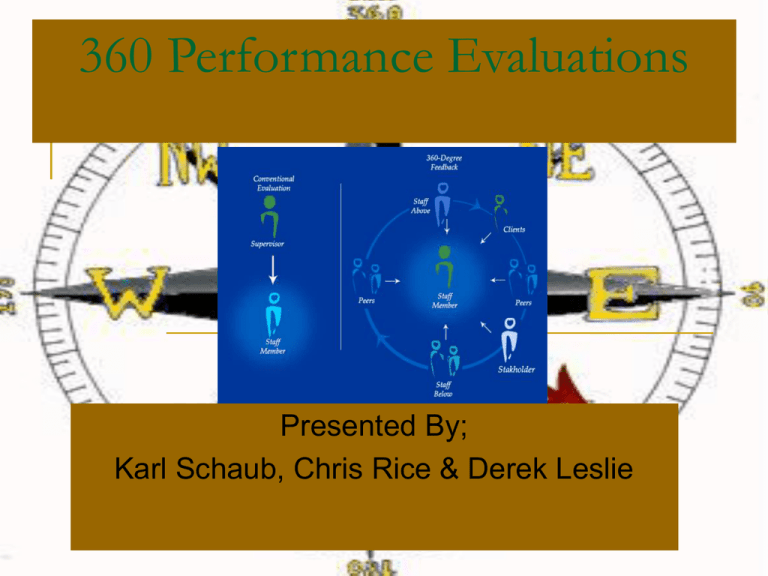What makes up a 360 Evaluation?
advertisement

360 Performance Evaluations Presented By; Karl Schaub, Chris Rice & Derek Leslie The Four Types 1. Top-Down Employee Performance Evaluations 2. Peer-to-Peer Employee Performance Evaluations 3. 360-Degree Performance Reviews 4. Self-Assessment Performance Reviews Top-Down Employee Performance Evaluations Most Common and Most Effective Assessment given directly from manager Most effective when the manager works with that employee daily Least effective when HR completes it on second hand knowledge Peer-to-Peer Employee Performance Evaluations Requires same level employees to review each other No one knows a worker better than those that work with them Can cause problems if evaluations get back to employees Self-Assessment Performance Reviews Employee asked to rate themselves Helps employee reflect on their performance and be an active part of their review Generally employees are harder on themselves 360-Degree Performance Reviews Customers, Suppliers, Piers, and direct reports Very effective if kept anonymous Every angle is accounted for and gives a true performance picture What 360 looks for. The 18 Universal Competencies Communication Listens to others Processes information Communicates effectively Adaptability Adjusts to circumstances Thinks creatively The 18 Universal Competencies Task Management Works efficiently Works competently Development of Others Cultivates individual talents Motivates successfully The 18 Universal Competencies Leadership Instills trust Provides direction Delegates responsibility Relationships Builds personal relationships Facilitates team success The 18 Universal Competencies Production Takes action Achieves results Personal Development Displays commitment Seeks improvement Example Questions For 360 Evaluations The Full Circle = 360 Degrees Self Evaluation The Self Evaluation This is the first evaluation given Usually just a paper that is given to employee and handed in to HR The form will contain questions that foster honest feedback They try to see themselves as others do The Self Evaluation This sets up a positive meeting with the manager Why? Because the manager will tend to evaluate better than an employee will Boss Evaluation The Boss Evaluation The Second Step of the process The supervisor looks at the employee as unbiased as possible It is key to not allow personal issues to block honest feedback The Boss Evaluation Even if the manager is biased the 360 method tends to account for it and will even it out Tardiness, work ethic, creativeness, etc are all taken into account from the managers perspective Peer Evaluation Peer Evaluation Third Step 5 evaluations are usually collected Information tends to be very accurate Biases are kept to a minimum as long as confidentiality is maintained Peer Evaluation Creates a picture for the employee being evaluated that is From other’s perspective Honest Eye opening Surprising Helpful Probably most accurate and truthful Direct Report Direct Report Final Step Given by those under the employee Sometimes it is shown that words and actions are not necessarily matching up Most helpful step for managers Direct Report Can come from Customers Suppliers Anyone under the employee Extremely honest because of the distance that is sometimes here for this report This Leads To Why is 360 Valuable to You? Identifies your strengths and weaknesses from the perspective of others. Improves your productivity and work relationships with those around you. Why 360 Fits For Today’s Workplace Jobs are many sided Cut backs at firms cause for employees to pick up more responsibilities Efficiency is becoming more important This system delivers great suggestions Why is 360 Valuable to You? Improves workplace morale. Provides a means to identify leadership competencies that need improvement. Serves as a training needs assessment. The 360 Evolution At the beginning it was designed for managers or career development Now the same evaluation process is used from the CEO down to Maintenance And both are contributing the each other’s evaluation Who Uses It? 90 percent of Fortune 1000 companies In our opinion every Company School Firm Sports Team Etc… Should use this system for Improvement Technology With the large numbers of employees there is a lot of information to keep track of Employee Management Software is being used It keeps track of trends Ensures secrecy for comments Gives the results quickly 360 Used For Pay Grades Goals for specific employees can be inputted into the 360 system How well everyone around the employee evaluates could indicate the amount of financial reward that employee receives Strategic Mission The purpose of doing 360 must be clearly defined If the mission is to develop and grow all employees must know that it is all for everyone's improvement If communication breaks down employees could fear everyone attacking them in the evaluations Be Careful You cannot be reckless with 360’s If there are not clear goals set ahead of time then… The evaluations will have no direction They will be hard to interpret It is best to have experts conduct these evaluations to ensure maximum effectiveness Intel and 360 Closely evaluated goals Kept employees accountable for their inputs Helped their employees to use evaluations accurately Carefully watch for Gaming Intel Continued They find with 360 prejudices related to Age Gender Race Religion Or any other factors This has lead to great successes for Intel Pros of 360 More comprehensive system because responses are gathered from multiple perspectives Feedback from peers and others may increase employee self-development Pros Continued It may lessen prejudices because the feedback comes from more people, not just one person Quality of information is better It complements TQM initiatives by emphasizing internal/external customers and teams Cons of 360 Requires training to work Employees could give dishonest and invalid feedback Can Be expensive Cons Continued Complex system in combining all responses Feedback can be intimidating. Employees could feel like they are being “attacked” Could be conflicting opinions, but accurate from their own standpoints In Conclusion Helps individuals and companies improve, grow and develope Provides honest and unbiased helpful feedback Increasing individuals performance with 360degree evaluations will lead to overall succes for a firm Has Anyone Ever Had A 360 Evaluation? Please briefly describe it What were your likes? Dislikes? Was it helpful











